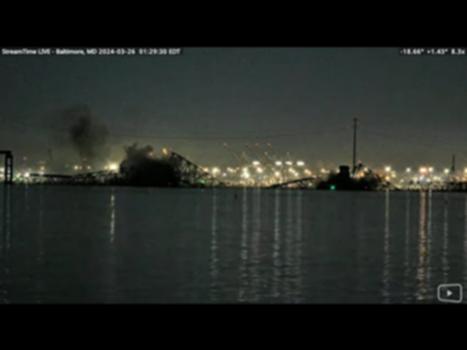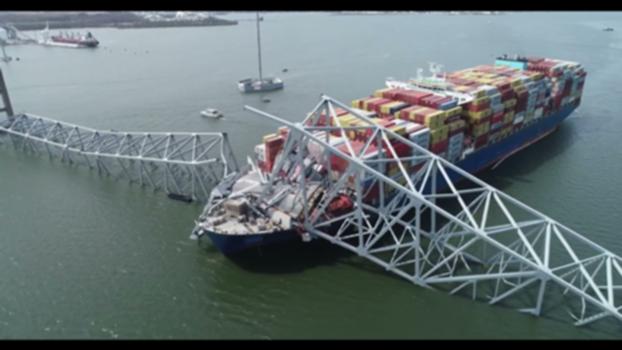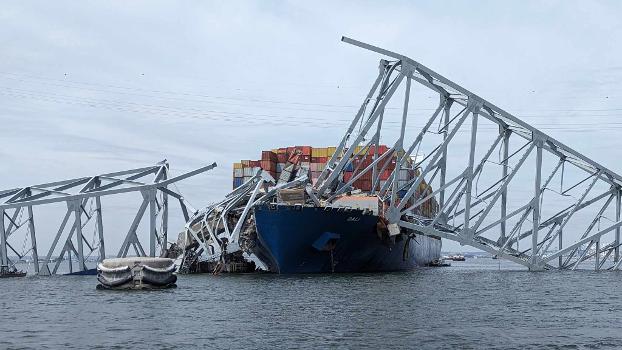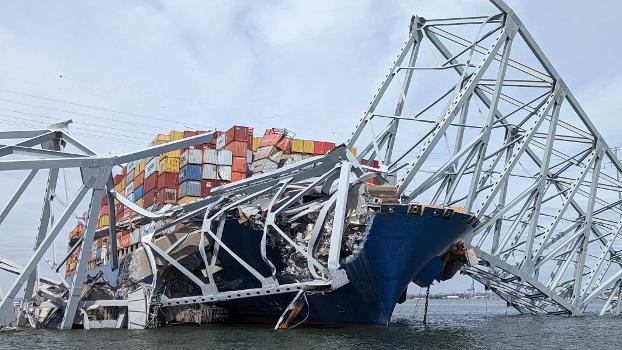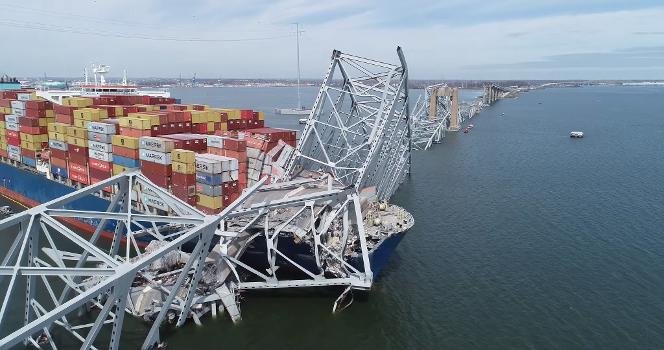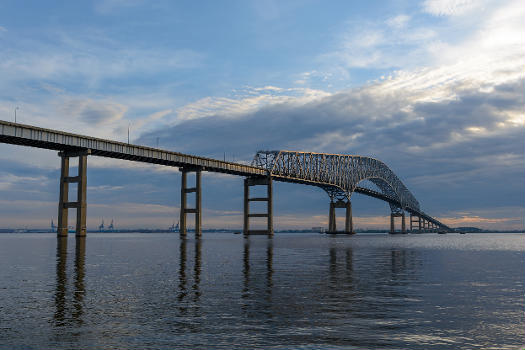General Information
| Other name(s): | Outer Harbor Crossing; Beltway Bridge |
|---|---|
| Beginning of works: | 1972 |
| Completion: | 23 March 1977 |
| Status: | collapsed (26 March 2024) |
Project Type
| Structure: |
Continuous truss bridge |
|---|---|
| Function / usage: |
Motorway bridge / freeway bridge |
| Material: |
Steel bridge |
| Support conditions: |
for registered users |
| Structure: |
Through truss bridge Truss bridge with suspended deck |
| Structure: |
Non-parallel chord truss bridge |
| Material: |
Structurae Plus/Pro - Subscribe Now! |
| Secondary structure(s): |
Structurae Plus/Pro - Subscribe Now! |
Awards and Distinctions
| 1978 |
Award of Merit
for registered users |
|---|
Location
| Location: |
Baltimore, Maryland, USA |
|---|---|
| Carries: |
|
| Crosses: |
|
| Coordinates: | 39° 13' 9.12" N 76° 31' 31.08" W |
Technical Information
Dimensions
| main span | 365.76 m | |
| total length | 2 632.25 m | |
| span lengths | 25 x 30.48 m - 9 x 91.44 m - 219.46 m - 365.76 m - 219.46 m | |
| number of lanes | 4 | |
| main bridge | ||
|---|---|---|
| span lengths | 219.46 m - 365.76 m - 219.46 m | |
Cost
| cost of construction | United States dollar 60 000 000 |
Materials
| piers |
reinforced concrete
|
|---|---|
| truss |
steel
|
Chronology
| 23 March 1977 | Opening. |
|---|---|
| 26 March 2024, 01:27 | The outbound cargo vessel Dali collides with one of the bridge piers causing the immediate collapse of that pier and the continuous truss main and side spans it supported. A road construction crew was present on the bridge section while it collapsed six of which are presumed dead. |
Excerpt from Wikipedia
The Francis Scott Key Bridge, known originally as the Outer Harbor Crossing until it was renamed in 1977 or simply as the Key Bridge or Beltway Bridge, was a steel arch-shaped continuous through truss bridge spanning the lower Patapsco River and outer Baltimore Harbor / Port carrying Maryland Route 695 in Baltimore, Maryland, United States. The main span of 1,200 feet (366 m) was the third longest span of any continuous truss in the world. It was the longest bridge in the Baltimore metropolitan area. On March 26, 2024 at 01:28 a.m. EDT (UTC–4), the bridge collapsed after the Singapore-flagged container ship Dali collided with one of its support pillars.
The bridge was opened in March 1977 and was named for amateur poet Francis Scott Key (1779–1843), the author of the American national anthem, the "Star Spangled Banner". The bridge was the outermost of three toll crossings of Baltimore's Harbor, two tunnels and one bridge. Upon completion, the bridge structure and its approaches became the final links in Interstate 695, the "Baltimore Beltway", completing a two decades long project. Despite the I-695 signage, the bridge was officially considered part of the state highway system and designated Maryland Route 695.
The bridge was 8,636 feet (2,632 m) long and carried an estimated 11.5 million vehicles annually. It was a designated hazardous materials truck route, as HAZMATs are prohibited in the Baltimore Harbor and Fort McHenry tunnels.
The Key Bridge was a toll facility operated by the Maryland Transportation Authority (MDTA). The toll rate for cars as of July 1, 2013 was $4.00. The bridge was part of the E-Zpass system, and included two dedicated E-Zpass lanes in its toll plaza in both the northbound and southbound directions. In April 2019, MDTA announced that the bridge would become a cashless toll facility by October 2019. With this system, customers without E-Zpass pay using video tolling. Cashless tolling began on the bridge on October 30, 2019.
History
In the 1960s, the old Maryland State Roads Commission concluded there was a need for a second harbor crossing after the earlier Baltimore Harbor Thruway and Tunnel opened in 1957. They began planning another single-tube tunnel under the Patapsco River, further to the southeast, downstream from the Baltimore Harbor Tunnel. The proposed site was between Hawkins Point and Sollers Point in the outer harbor. Plans also were underway for a drawbridge to the south over Curtis Creek, replacing an earlier 1931 drawbridge carrying Pennington Avenue over the creek, to connect Hawkins Point to Sollers Point.
At the same time, a bridge was planned for the segment of an additional through highway for the East Coast with I-95 that would run through the city near Fort McHenry and paralleling the Harbor Tunnel Thruway. This was replaced by what is now known as the Fort McHenry Tunnel, a major expensive project, a four-tube facility running under and curving around historic Fort McHenry, that opened in 1985.
The project was financed by a $220 million bond issue alongside the twinning of the Chesapeake Bay Bridge in October 1968. Contractors took bearings of the outer harbor bottom and ship channel in the spring of 1969. Bids for construction of the proposed Outer Harbor Tunnel were opened in July 1970, but price proposals were substantially higher than the engineering estimates. Officials drafted alternative plans, including a four-lane bridge, which was approved by the General Assembly in April 1971.
The bridge, at an estimated cost of $110 million, would have more traffic lanes and lower operating and maintenance costs than a tunnel. A bridge would provide a route across the Baltimore Harbor for vehicles transporting hazardous materials, which are prohibited from both the Baltimore Harbor and Fort McHenry tunnels. The United States Coast Guard issued its bride permit in June 1972, replacing an earlier approval of the tunnel from the Army Corps of Engineers. Construction of the Outer Harbor Bridge began in 1972, several years behind schedule and $33 million overbudget.
The bridge was named in 1976 for Francis Scott Key, who wrote The Star-Spangled Banner after witnessing the bombardment of Fort McHenry during the Battle of Baltimore in September 1814. Key had been aboard an American truce ship with the British Royal Navy fleet in Baltimore Harbor near Sollers Point; the approximate location is 100 yards (91 m) of the bridge and marked by a buoy in the colors of the U.S. flag. Another Francis Scott Key Bridge crosses the Potomac River in Washington, D.C.
The Key Bridge opened to traffic on March 23, 1977. Including its connecting approaches, the bridge project was 10.9 miles (17.54 km) in length. Other structures along the thruway included a 0.64-mile (1.03 km) dual-span drawbridge over Curtis Creek and two 0.74-mile (1.19 km) parallel bridge structures that carry traffic over Bear Creek.
The bridge opened with four lanes, but its approaches were two lanes to reduce costs. The south approach was widened in 1983. A project for the north approach was completed in 1999 after several years of delays. The delay was attributed in part to the widening's impacts on a Bethlehem Steel plant in Sparrows Point.
Collapse
On March 26, 2024, at around 01:27 EDT (05:27 UTC), the entirety of the through truss bridge collapsed after the Singaporean container ship Dali collided with one of the support pillars. The collapse has been called a mass casualty incident. An unknown number of vehicles and construction workers were on the bridge at the time of the collision and subsequent collapse.
Text imported from Wikipedia article "Francis Scott Key Bridge (Baltimore)" and modified on March 26, 2024 according to the CC-BY-SA 4.0 International license.
On March 26, 2024, at 01:27 EDT (05:27 UTC), the entirety of the through truss section of the Francis Scott Key Bridge in Baltimore, Maryland, collapsed after one of its support pillars was destroyed by being struck by the container ship Dali, registered in Singapore.
The ship was heading to Colombo, Sri Lanka. According to a Baltimore City Fire Department spokesperson, at least seven vehicles fell into the water.
Background
The Francis Scott Key Bridge opened in 1977 and spans the Patapsco River, a vital shipping route in the Port of Baltimore and the east coast of the United States. It is also part of Interstate 695, a beltway around Baltimore. The bridge had a length of 1.6 miles (2.6 km) and carried four lanes, two in each direction.
Collapse
The ship involved, Dali, is a Singapore-registered cargo vessel. The 229-metre-long (751 ft) ship left Baltimore at 01:00 EDT for Colombo, Sri Lanka. It struck a column of the bridge at 01:27 EDT. The bridge strike and collapse was recorded on video. The bridge broke apart in several places following the collision. A Baltimore City Fire Department (BCFD) spokesperson said vehicles were on the bridge at the time it collapsed, including one that was the "size of a tractor-trailer". The Dali caught fire and appeared to sink, with a section of the bridge landing on its front part.
Aftermath
Emergency teams began receiving 911 calls at 01:30. The BCFD stated that several vehicles and seven individuals fell into the river. A Maryland Transportation Authority representative on scene told rescuers that they had at least 20 workers on the bridge at the time of collapse. Large-scale rescue and recovery efforts were put underway. The Baltimore City police department was alerted to the collapse at 01:35. Mayor of Baltimore Brandon Scott stated that emergency personnel were in attendance and that he was en route to the site.
Text imported from Wikipedia article "Francis Scott Key Bridge collapse" and modified on March 26, 2024 according to the CC-BY-SA 4.0 International license.
Participants
- Baltimore Transportation Associates
- Greiner Engineering Sciences, Inc.
- Singslad Kehan, November & Hurka
Relevant Web Sites
-
An engineer's Guide to Baltimore: Francis Scott Key Bridge

-
ASCE: Baltimore’s Francis Scott Key Bridge opens

-
DC Roads: Francis Scott Key Bridge (I-695)

-
NTSB: Contact of Cargo Vessel Dali with Francis Scott Key Bridge and Subsequent Bridge Collapse

-
Roads to the Future: Francis Scott Key Bridge (Outer Harbor Crossing)

-
Wikipedia: Francis Scott Key Bridge (Baltimore)

-
Wikipedia: Francis Scott Key Bridge collapse

Relevant Publications
- (1994): Brücken / Bridges. Ästhetik und Gestaltung / Aesthetics and Design. 4th edition, Deutsche Verlags-Anstalt, Stuttgart (Germany), pp. 175.
- About this
data sheet - Structure-ID
20000501 - Published on:
16/11/1999 - Last updated on:
27/03/2024


